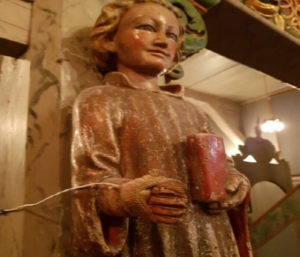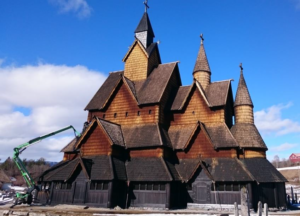Acoustic emission monitoring of historical wooden objects to support environmental management
Wooden historical objects, usually covered with decorative layers – panel paintings, polychrome wooden sculptures, furniture – are among the category of cultural objects most vulnerable to humidity and temperature fluctuations, and most frequently found in museum collections and historical interiors of various kinds.
Experts of the Institute’s Cultural Heritage Group has successfully used an instrumental technique – acoustic emission analysis (AE) to monitor with precision crack propagation at the micrometric level in valuable historical wooden objects. AE is defined as the energy released due to physical damage in a structure experiencing stress due to some deterioration process. Energy passes through the material as ultrasound and sound waves and is detected on the surface by a microphone which converts the surface vibration to an electrical signal. The technique is non-invasive, economically viable, continuous and capable of operating in real-world conditions in museums and historical buildings.
| Measurements for a richly decorated French commode, dated 1760-1765, displayed in the Furniture Gallery of the Victoria & Albert Museum in London | |
 |
 |
The commode is an exquisite example of luxury European Rococo furniture in which original Japanese lacquer panels, obtained from Japanese screens or cabinets, were re-used as thin sheets to decorate new furniture. For the monitoring of possible crack growth, the microphones recording AE were mounted inside the piece near existing cracks (right).
| Measurements for a unique collection of furniture at Knole in the UK | |
 |
 |
Knole in Kent, a country house established in the 15th century is home to one of the National Trust’s most important collections of furniture, including rare 17th century tables, torchères and chairs. Many objects remained in place at Knole for 300 years in rooms subject to the natural climate of high relative humidity which raised legitimate concerns about possible damage from mould growth. Therefore, the implementation of controlled indoor heating to reduce the average relative humidity was attempted. We carried out the AE monitoring to verify if the movement of Knole’s furniture from an uncontrolled environment to controlled drier conditions involved any risk of wood’s damage.
| Measurements in the interiors of stave churches in Norway | |
 |
 |
The 28 preserved stave churches represent Norway`s most precious and important contribution to UNESCO’s World Heritage, as they exhibit a unique development in timber-based architecture and technology over the Middle Ages. To keep alive this unique heritage asset, an effective and sustainable long-term management plan of these buildings is a necessity. We monitored the climate-induced crack propagation in wooden elements in two churches stave churches in Ringebu and Kvernes, dated to 12th-15th centuries. The churches differ in the pattern of use during winter: the Kvernes church is unheated and the Ringebu church is heated which might engender large drops in relative humidity in the frost periods. The monitoring has supported conservation strategies which take into account different environmental conditions and patterns of use, so that resources are saved and the attractiveness of the sites to visitors is increased.
Our AE monitoring campaigns in museums and historic interiors demonstrated that amazing sensitivity and reproducibility of the AE sensors allow risk of climate-induced physical damage to be precisely assessed for conservation and museum community. The developed technique has a considerable potential to support evaluation of existing climatic control strategies and the development of improved ones, based on the specific needs of the monitored objects, so that their long-term preservation is optimally reconciled with the need to control the investment and operating costs of the climate control systems.
Further reading:
- Strojecki M., Łukomski M., Krzemień L., Sobczyk J., Bratasz Ł. (2014), Acoustic emission monitoring of an eighteenth century wardrobe to support a strategy for indoor climate management, Studies in Conservation, 59, 225–232.
- Łukomski M., Strojecki M., Pretzel B., Blades N., Beltran V., Freeman A. (2017), Acoustic emission monitoring of micro-damage in wooden art objects to assess climate management strategies, Insight, 59, 256-264.